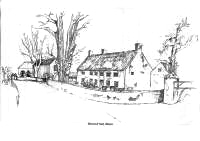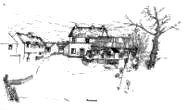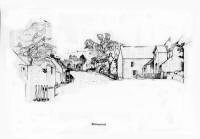| HILLSBOROUGH Hillsborough as a town remains largely unspoiled as an area of good buildings of the 18th and early 19th century. The town received a corporated chatter in 1661 and was laid out in the first half of the 78th century. There is a wealth of late Georgian buildings in the town. St. Malachy's Parish Church was built in the 18th century by Wills Hill, later the 1st Marquis of Downshire. Dr. Rowan describes it as a remarkable example of 18th century Gothic, and many of the details such as the crackers at the intersection of the towers are typical of 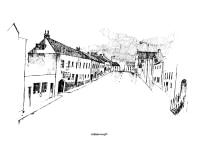 Miller's designs. . ." Few
architects could have built such a large and comparatively competent Gothic
structure in the early 1760's and of those who could, only Miller is known
to have made designs for Irish buildings. Wills Hill had hoped his church
would be accorded cathedral status but he was disappointed. Internally the
church is quite unspoiled - though somewhat altered by Sir Thomas Drew in
1898, and is particularly notable for the quality of its woodwork; high
plain oak pews, very fine tall octagonal pulpit with sounding board and
bishop's throne. It contains the Snetzler organ of 1773, and a smaller organ
of 1795 by England. The church is magnificently sited on the hillside off
the main street, close to, and just below, the Fort. It is approached by a
broad grass avenue flanked by tall lime trees, interspersed with
rhododendrons. There is close to the church a curious pinnacled gateway of
soft stone which seems much earlier than the present church - possibly a
survivor of the church of 1636; it now leads to the churchyard, but formerly
provided-an access route through gardens from their houses for the organist
and the agent. A memorial to the composer Hamilton Harty carved by the late
Rosamund Praeger also stands close to the church. Miller's designs. . ." Few
architects could have built such a large and comparatively competent Gothic
structure in the early 1760's and of those who could, only Miller is known
to have made designs for Irish buildings. Wills Hill had hoped his church
would be accorded cathedral status but he was disappointed. Internally the
church is quite unspoiled - though somewhat altered by Sir Thomas Drew in
1898, and is particularly notable for the quality of its woodwork; high
plain oak pews, very fine tall octagonal pulpit with sounding board and
bishop's throne. It contains the Snetzler organ of 1773, and a smaller organ
of 1795 by England. The church is magnificently sited on the hillside off
the main street, close to, and just below, the Fort. It is approached by a
broad grass avenue flanked by tall lime trees, interspersed with
rhododendrons. There is close to the church a curious pinnacled gateway of
soft stone which seems much earlier than the present church - possibly a
survivor of the church of 1636; it now leads to the churchyard, but formerly
provided-an access route through gardens from their houses for the organist
and the agent. A memorial to the composer Hamilton Harty carved by the late
Rosamund Praeger also stands close to the church.The church screen, Sexton's House and Parish Room is of exceptional merit and interest; at each end is a long low pavilion with three little Gothic spirelets; both were originally school houses, one for infants and girls, the other for boys. The former is now the Sexton's House, the latter the Parish Room. Between them, divided by railings and splendid gates are four square piers, with round shafts at the Angles each surmounted by four ball-shaped finials. Hillsborough Fort was built by Arthur Hill about 1650. The ramparts are of earth, eight feet high, with a revetment of random stone, and overlooking the town, the church and the artificial lake. The gatehouse is a rectangular two-storey structure of rubble masonry, with brick dressings and fortifications and tall square corner towers. The Fort was presented to the State by the Downshire family in 1959. The Markethouse is an unusual and charming building in three blocks arranged pyramidally; on a plinth of granite steps, the ground floor has a frontage of nine bays and sides of five bays, with round open arches in the central block, and round-headed windows in the subsidiary pyramidal roofed blocks; the central square black of three bays rises another storey. Above this is a square clock tower with urns, cupola, and banner weathervane. Hillsborough Castle, formerly Government House, is a pleasant, if not very imposing two-storey building and is mainly the work of R. F. Brettingham, completed in 1797, four years after the death of the first Marquis. The building seems to incorporate the remnants of a much smaller house of 1760, the building was much enlarged and considerably remodelled in the 1830's and 1840's. 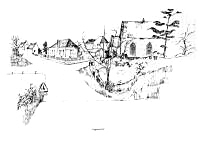 Almost all the credit for the layout and design of Hillsborough must be
given to Wills Hill (the first Marquis of Downshire) who was a remarkable
man with great appreciation of architecture of the Georgian period. The
Hills were English "Planters" who came to the little place called 'Cromlyn'
(the crooked Glen) where Hillsborough now stands. It was the stronghold of
the Maginesses who for generations had controlled the surrounding
countryside. The first of the Hills to arrive was Moyses Hill, who arrived
with the army of Elizabeth I. He married a sister of Sorley Boy MacDonnell
of Dunluce and eventually settled down at the old hamlet of Cromlyn. The old
castle of the Maginess clan was strengthened by Peter Hill (son of Moyses
Hill) who eventually ousted the Maginess family and built the fart. The
family fortunes grew to such an extent that by the end of the 17th century
the family estate was one of the largest in the British Isles. Almost all the credit for the layout and design of Hillsborough must be
given to Wills Hill (the first Marquis of Downshire) who was a remarkable
man with great appreciation of architecture of the Georgian period. The
Hills were English "Planters" who came to the little place called 'Cromlyn'
(the crooked Glen) where Hillsborough now stands. It was the stronghold of
the Maginesses who for generations had controlled the surrounding
countryside. The first of the Hills to arrive was Moyses Hill, who arrived
with the army of Elizabeth I. He married a sister of Sorley Boy MacDonnell
of Dunluce and eventually settled down at the old hamlet of Cromlyn. The old
castle of the Maginess clan was strengthened by Peter Hill (son of Moyses
Hill) who eventually ousted the Maginess family and built the fart. The
family fortunes grew to such an extent that by the end of the 17th century
the family estate was one of the largest in the British Isles.Modern Hillsborough largely bears testament to the work of Wills Hill and with the re-routing of the main Dublin-Belfast road to by-pass the town it is hoped to further preserve the character and develop interest in the town. The Council Office on the site of the old 18th century inn (destroyed by fire in 1943 is an example of new Georgian architecture and is the administrative centre for the Lisburn borough area. Both public and private schemes for residential development have approval in Hillsborough, notably in the Carnreagh and Culcavy areas (see Culcavyl. It is, in the future, proposed to have a small industrial estate at Culcavy. Hillsborough should expand considerably over the next few years. Guide to further reading The Borough Council has a series of Environmental Exploration booklets in preparation and these should be of interest to those members of the public who wish to explore settlements in the Borough. LAMBEG Lambeg stands on the Lagan just east of Lisburn and on the main rail and road route to Belfast. The village grew up around the local linen industry and has grown considerably in recent years. The linen industry sited its research centre near Lambeg and its laboratories have been at the forefront of all new linen development processes in Ulster. The area gave its name to the Lambeg drum which can still 6e seen in Orange Order processions. The Lagan river flows through the area as does part of the now disused Lagan Navigational Canal which linked Belfast to Lough Neagh. The 620 foot White Mountain is to the west and is the westerly extremity of the Belfast Hills. MAGHABERRY Approval has been given recently to develop five acres of land for private residential purposes. With the construction of a new prison it is expected that there will be further development in the village. MAZE Close to this village on the south bank of the Lagan is the Down Royal Racecourse, where the Ulster Harp Derby is run on July 13 year year. It is the oldest racecourse in Ireland. Future development of the village is uncertain.
MOIRA STONEYFORD |


